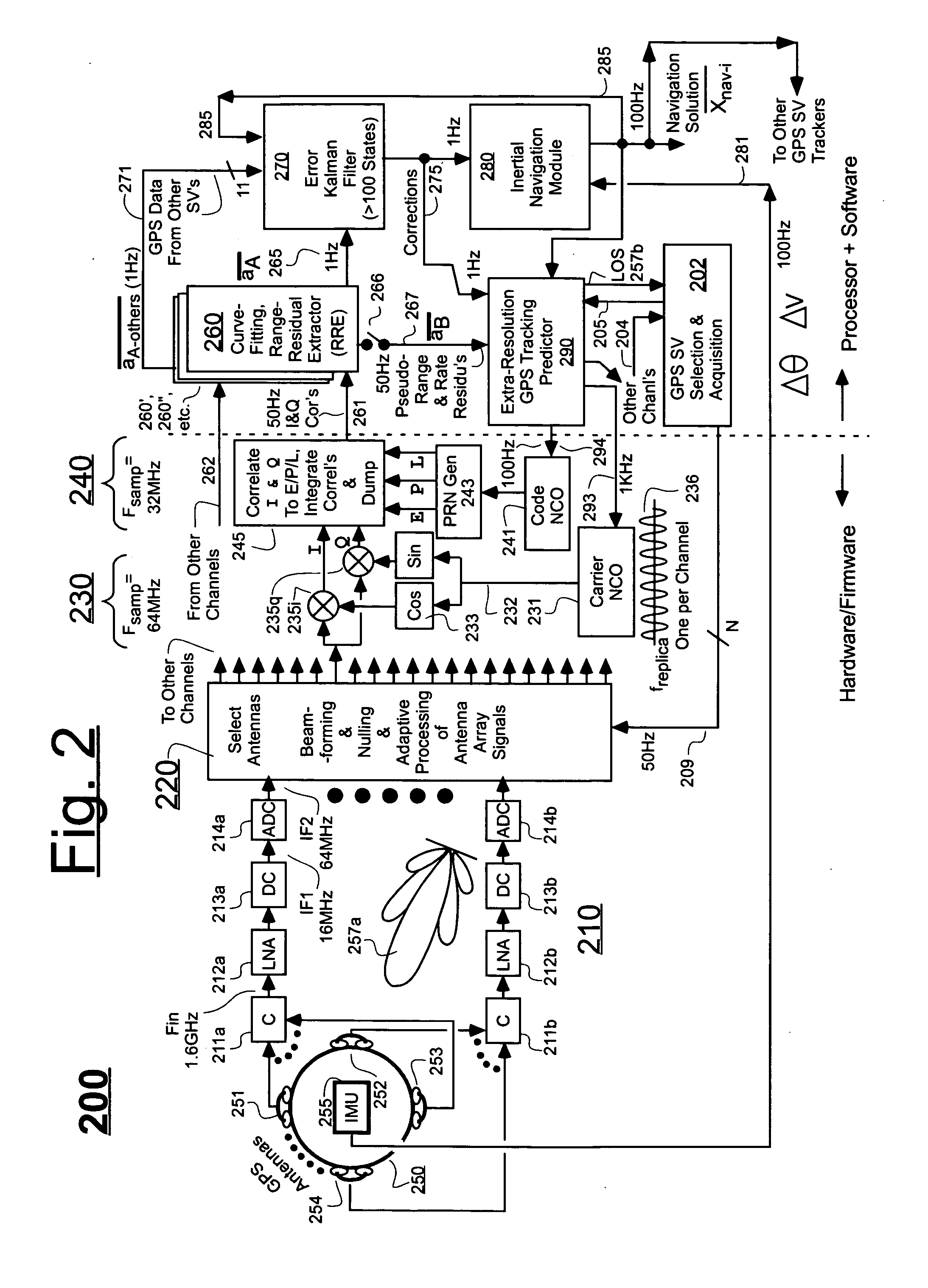Ultra-tightly coupled GPS and inertial navigation system for agile platforms
a technology of inertial navigation and tight coupling, applied in the direction of navigation instruments, instruments, process and machine control, etc., can solve the problems of gps system noise, loss of signal tracking, and inability to provide a standalone correct solution for gps system, so as to reduce computation time, improve phase and frequency lock, and remove noise
- Summary
- Abstract
- Description
- Claims
- Application Information
AI Technical Summary
Benefits of technology
Problems solved by technology
Method used
Image
Examples
embodiment 200
[0044] The processing of only one of the GPS channels will now be described for understanding of the carrier lock-on section 230. It is to be understood that the same structure is repeated for each of other GPS channels but these are not shown in order to preserve illustrative clarity. A GPS channel may be defined as corresponding to a given GPS frequency band and also to a given PRN code sequence. Typically, for each given GPS vehicle, a different PRN code sequence is assigned for each of that vehicle's output bands. Each given GPS vehicle will typically have more than one output channel associated with it. For example, if there are 12 in-view vehicles and each transmits on the L1 and L2 bands, there can be a total of 24 received channels (two for each GPS vehicle). The on-platform system 200 of FIG. 2 tries to generate a local and respective, carrier replica signal 236 for each of its active GPS channels. Thus carrier lock-on is performed on a per-channel basis in this embodiment ...
embodiment 400
[0069] Referring to FIG. 4A, in the illustrated embodiment 400, all four of the main modules (460, 470, 480 and 490—these correspond to 260, 270, 280 and 290 of FIG. 2) operate in rough synchronism with one another even though some may internally step forward faster than the others. The big EKF 470 produces a new corrections 475 once every 1000 ms (1 Hz rate). The curve fitting RRE 460 has its internal m value adjusted so as to also produce new set of GPS-based measurement residuals once every 1000 ms (1 Hz rate). Even though the internal timing clock 487 of the INM 480 triggers 100 times faster (at a 100 Hz rate) to produce new navigation solution samples onto line 485 every 10 ms, a 1 Hz sampling switch 486 is interposed between the INM 480 and the big EKF 470 so that the EKF 470 receives the latest navigation solution for its internal line 468 only once every 1000 ms (1 Hz rate). The big EKF 470 of this embodiment cannot absorb new measurement data any faster than this because it...
embodiment 600
[0095] Instead of operating in the frequency domain, the 2-stage carrier wipe-off embodiment 600 of FIG. 6 performs a timing shift in the time domain on a per channel basis buy se of the illustrated, carrier phase rotation, and average-down (sum & dump) modules such as 646. To understand on a crude level why this works, it should be appreciated that the feedback loop 675′ that urges the carrier NCO 631 towards approximate, frequency lock-on with the incoming signals of a given band (e.g., L1) is simultaneously performing an approximate, phase lock on. If the replica signal 636 is falling behind the incoming PRN's of the given band (e.g., L1), then the EKF feedback loop signal 675′ will advance the output frequency of NCO 631, thereby causing it to also advance in phase so as to catch up with the incoming PRN streams. Accordingly, the once demodulated outputs 637 of multipliers 635 will be close to being in phase with the output sine and cosine waveforms of generators 633. A small ph...
PUM
 Login to View More
Login to View More Abstract
Description
Claims
Application Information
 Login to View More
Login to View More - R&D
- Intellectual Property
- Life Sciences
- Materials
- Tech Scout
- Unparalleled Data Quality
- Higher Quality Content
- 60% Fewer Hallucinations
Browse by: Latest US Patents, China's latest patents, Technical Efficacy Thesaurus, Application Domain, Technology Topic, Popular Technical Reports.
© 2025 PatSnap. All rights reserved.Legal|Privacy policy|Modern Slavery Act Transparency Statement|Sitemap|About US| Contact US: help@patsnap.com



